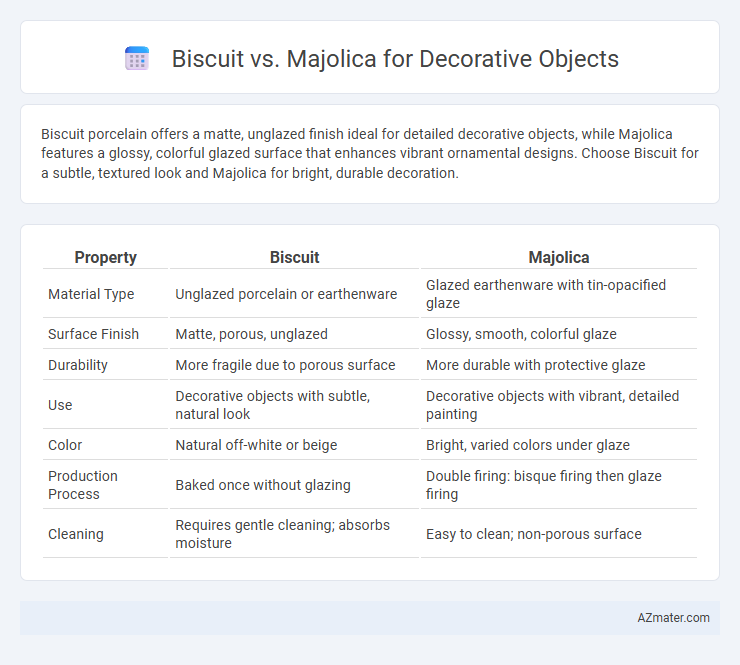Biscuit porcelain offers a matte, unglazed finish ideal for detailed decorative objects, while Majolica features a glossy, colorful glazed surface that enhances vibrant ornamental designs. Choose Biscuit for a subtle, textured look and Majolica for bright, durable decoration.
Table of Comparison
| Property | Biscuit | Majolica |
|---|---|---|
| Material Type | Unglazed porcelain or earthenware | Glazed earthenware with tin-opacified glaze |
| Surface Finish | Matte, porous, unglazed | Glossy, smooth, colorful glaze |
| Durability | More fragile due to porous surface | More durable with protective glaze |
| Use | Decorative objects with subtle, natural look | Decorative objects with vibrant, detailed painting |
| Color | Natural off-white or beige | Bright, varied colors under glaze |
| Production Process | Baked once without glazing | Double firing: bisque firing then glaze firing |
| Cleaning | Requires gentle cleaning; absorbs moisture | Easy to clean; non-porous surface |
Introduction to Biscuit and Majolica Decorative Objects
Biscuit decorative objects are unglazed porcelain pieces known for their matte, soft finish and delicate, detailed craftsmanship, often used in fine art and collectible figurines. Majolica decorative objects feature vibrant, colorful glaze with a glossy finish created through tin-glazing techniques, popular in pottery and ceramics for ornamental and functional purposes. Both Biscuit and Majolica carry rich historical significance, with Biscuit prized for its purity and Majolica celebrated for its vivid, artistic surface decoration.
Historical Origins of Biscuit vs. Majolica
Biscuit porcelain, originating in 18th-century Europe, is known for its unglazed, matte finish resembling fine sculpture, often used for delicate decorative objects that emphasize form and texture. Majolica, developed during the Renaissance in Italy and later popularized in Victorian England, features tin-glazed pottery with vibrant, colorful designs applied over a white, opaque glaze, making it prominent for ornamental and functional wares. Both styles reflect distinct cultural aesthetics and technological innovations in ceramics from their respective historical contexts.
Material Composition: Biscuit Porcelain vs. Majolica Earthenware
Biscuit porcelain is an unglazed, white, and matte-finished ceramic made from refined kaolin clay, known for its delicate and translucent quality. Majolica earthenware features a porous terracotta body coated with a tin glaze that creates a glossy, vibrant surface decorated with colorful patterns. The key material difference lies in biscuit's dense, high-fired porcelain composition versus majolica's lower-fired, glazed earthenware base.
Surface Finish: Matte vs. Glazed
Biscuit ceramic features a matte, unglazed surface that highlights its natural, porous texture, making it ideal for a soft, muted aesthetic in decorative objects. Majolica, on the other hand, is characterized by a glossy, brightly glazed finish that enhances color vibrancy and provides a waterproof surface, adding durability to ornamental pieces. The choice between biscuit and majolica finishes significantly influences the visual appeal and functional properties of decorative ceramics.
Crafting Techniques and Processes
Biscuit and Majolica differ significantly in crafting techniques, with Biscuit referring to unglazed porcelain fired at high temperatures to achieve a matte, smooth finish that highlights fine details and texture. Majolica, on the other hand, involves tin-glazed earthenware with a distinctive glossy, colorful surface achieved through low-temperature firing and brush-applied metal oxide pigments. The processes for Biscuit emphasize careful kiln control to avoid glaze, while Majolica requires precise layering and firing techniques to maintain vibrant, decorative glazes.
Visual Aesthetics: Color and Texture Differences
Biscuit porcelain features a matte, unglazed surface that provides a soft, chalky texture, emphasizing fine detail and subtlety in sculptural forms. Majolica, on the other hand, showcases vibrant, glossy glazes with rich, varied colors and a smooth, tactile finish that highlights decorative patterns and visual complexity. The contrast between Biscuit's muted tones and Majolica's vivid hues creates distinctly different visual aesthetics tailored to classic elegance versus lively ornamentation.
Durability and Longevity in Home Decor
Biscuit porcelain, characterized by its unglazed, matte finish, offers moderate durability but is more susceptible to chipping and staining compared to glazed surfaces. Majolica, with its vibrant, glazed finish, provides superior resistance to moisture, scratches, and wear, making it more suitable for long-lasting decorative objects in home decor. For exterior or high-traffic display, Majolica's durability and color preservation render it a preferred choice over Biscuit porcelain.
Iconic Designs and Famous Examples
Biscuit porcelain offers a matte, unglazed finish ideal for detailed, lifelike figurines like those from Royal Copenhagen or Meissen, emphasizing texture and form in iconic designs such as the Blue Fluted figurines. Majolica, characterized by its vibrant, glossy glaze and intricate, colorful patterns, is exemplified by Victorian-era English manufacturers like Minton and Wedgwood, celebrated for botanical motifs and whimsical scenes. Both materials highlight distinct artistic traditions: biscuit for subtle elegance and majolica for bold, decorative vibrancy in collectible decorative objects.
Maintenance and Care Tips
Biscuit porcelain, being unglazed and porous, requires gentle dusting and occasional sealing to prevent stains and moisture absorption, making it more delicate in maintenance. Majolica features a glazed, glossy finish that resists dirt and moisture, allowing for easier cleaning with a damp cloth and mild soap without risk of damage. For longevity, store biscuit pieces in low-humidity environments, while majolica can tolerate typical indoor conditions but should be shielded from abrasive cleaners to preserve its vibrant glaze.
Choosing Between Biscuit and Majolica for Decoration
Biscuit porcelain offers a matte, unglazed finish that highlights fine details and creates an elegant, understated decorative effect, ideal for classic and minimalistic interiors. Majolica, by contrast, features a vibrant, glossy glaze with rich, colorful patterns, making it perfect for bold, eye-catching accents in eclectic or Mediterranean-inspired spaces. Choosing between biscuit and majolica depends on the desired aesthetic impact and maintenance preferences, with biscuit providing a subtle texture and majolica delivering vivid durability.

Infographic: Biscuit vs Majolica for Decorative object
 azmater.com
azmater.com